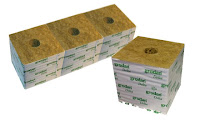Techniques
The two main types of hydroponics are solution culture and medium culture. Solution culture does not use a solid medium for the roots, just the nutrient solution. The three main types of solution culture are static solution culture, continuous flow solution culture and aeroponics. The medium culture method has a solid medium for the roots and is named for the type of medium, e.g. sand culture, gravel culture or rockwool culture. There are two main variations for each medium, subirrigation and top irrigation. For all techniques, most hydroponic reservoirs are now built of plastic but other materials have been used including concrete, glass, metal, vegetable solids and wood. The containers should exclude light to prevent algae growth in the nutrient solution.
Media
Nowadays, the global greenhouse industry uses the following media. Coir (coco peat), perlite and rockwool.
Rockwool
 Rockwool is the most widely used medium in hydroponics. Made from basalt rock it is heat-treated at high temperatures then spun back together like candy floss. It comes in lots of different forms including cubes, blocks, slabs and granulated or flock.Rockwool is an excellent inert substrate for both 'free drainage' and recirculating systems. In free drainage or run-to-waste systems, the chance of disease spread is greatly lessened. Rockwool is also lightweight and self-contained, which allows plants to be grown at different densities in different stages - young plants can be grown to an advanced stage in a small area before being planted out into the main growing area, thus improving crop turnaround. Its light weight also permits setting up to be quick and inexpensive. Because it is light and rigid it eliminates back-breaking work in preparation and planting and gives substantial labor-saving costs. Rockwool is noted for providing a favorable root environment, thus minimizing plant stress. Root temperature can also be controlled, thus giving substantial energy savings. Rockwool initially causes an increase in pH level. You must adjust the pH level of the nutrient solution to counteract this. A pH level of 5.5-6.5 should suffice to create a suitable pH.
Rockwool is the most widely used medium in hydroponics. Made from basalt rock it is heat-treated at high temperatures then spun back together like candy floss. It comes in lots of different forms including cubes, blocks, slabs and granulated or flock.Rockwool is an excellent inert substrate for both 'free drainage' and recirculating systems. In free drainage or run-to-waste systems, the chance of disease spread is greatly lessened. Rockwool is also lightweight and self-contained, which allows plants to be grown at different densities in different stages - young plants can be grown to an advanced stage in a small area before being planted out into the main growing area, thus improving crop turnaround. Its light weight also permits setting up to be quick and inexpensive. Because it is light and rigid it eliminates back-breaking work in preparation and planting and gives substantial labor-saving costs. Rockwool is noted for providing a favorable root environment, thus minimizing plant stress. Root temperature can also be controlled, thus giving substantial energy savings. Rockwool initially causes an increase in pH level. You must adjust the pH level of the nutrient solution to counteract this. A pH level of 5.5-6.5 should suffice to create a suitable pH.Nutrient solutions
Plant nutrients are dissolved in the water used in hydroponics and are mostly in inorganic and ionic form. Primary among the dissolved cations (positively-charged ions) are Ca2+ (calcium), Mg2+ (magnesium), and K+ (potassium); the major nutrient anions in nutrient solutions are NO3− (nitrate), SO42− (sulphate), and H2PO4− (phosphate).
Numerous 'recipes' for hydroponic solutions are available (DKG Consulting provides our recipes). Many use different combinations of chemicals to reach similar total final compositions. Commonly-used chemicals for the macronutrients include potassium nitrate, calcium nitrate, potassium phosphate, and magnesium sulfate. Various micronutrients are typically added to hydroponic solutions to supply essential elements; among them are Fe (iron), Mn (manganese), Cu (cooper), Zn (zinc), B (boron), Cl (chlorine), and Ni (nickel). Chelating agents are sometimes used to keep Fe soluble.
Hydroponics fertilizers and other types of formulas for hydroponics have changed drastically during the last ten years. Many of these changes have resulted in measurably significant increases in plant growth rates, plant resistance to diseases and pests, and plant yields.
For more information please visit our exclusive website for hydroponics












